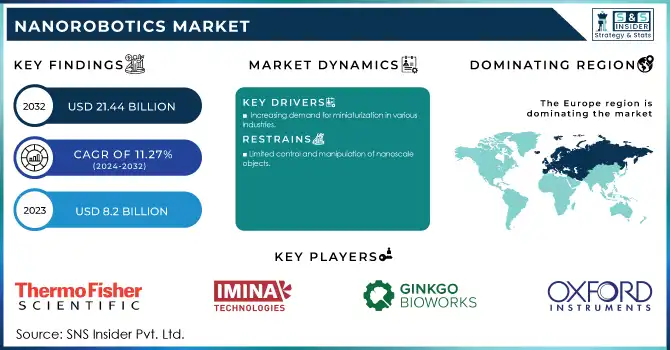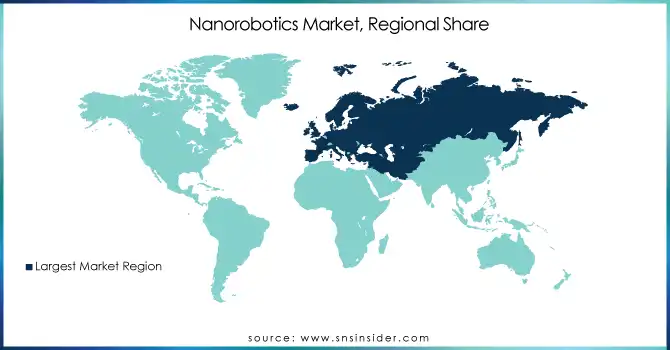Nanorobotics Market Report Scope & Overview:
The Nanorobotics Market size was valued at USD 7.87 billion in 2023 and expected to reach to USD 21.53 billion by 2032 and grow at a CAGR of 11.27 % over the forecast period of 2024-2032. The growing adoption of Nano robots in the medical industry for targeted drug delivery as well as the demand for minimally invasive medical treatments. Adoption and usage data can vary from region to region with regions currently savvy in scientific and technological art around nanorobotics (with notable presence from major tech innovators) continuing to make headway with new product development and solidifying investor interest. Moreover, regulatory and safety data are prominent by region for market expansion in addition to user experience and feedback which are actively influencing the future of nanorobotics technologies.

Nanorobotics Market Dynamics
Drivers:
-
Increasing Demand for Precision Medicine through Nanorobotics
The rising demand for precision medicine is a significant driver for the Nanorobotics Market. Nano robots allow for highly targeted drug delivery and personalized treatments improving the efficacy of therapy reducing side effects. They are also key for early disease detection and precision diagnostics that is revolutionizing healthcare. Among numerous data-driven changes, one area of exploration in recent years has been nanorobotics, which, thanks to the advances in nanotechnology, is particularly experiencing efforts in medical applications to provide more efficient and less invasive treatments. This trend is set to continue, with increasing need for personalized care. In related developments, Zhou and colleagues have designed nanobots measuring just 295 nanometers, smaller than most viruses, to address aneurysm-related strokes.
Restraints:
-
Regulatory and safety challenges in the nanorobotics market encompass toxicity, ethical concerns, and approval hurdles.
The integration of nanotechnology in healthcare raises significant concerns regarding long-term safety, potential toxicity, and the regulatory hurdles that delay market entry. Health risks, such as accumulation of Nano robots in tissues or unintended bio interactions, will have to be tested extensively based on which clinical evaluation will be performed. Strict regulations are necessary to make sure these technologies pass safety tests, but long approval procedures hinder the pace of implementation. All these factors, along with the challenge of standardizing Nano robot designs and the need to create effective monitoring systems, make regulation even more complex. Issues of this nature, along with public perception issues relating to Nano robot safety and privacy issues, pose an underlying barrier to the advancement of nanorobotics as a mainstream practice within health care.
Opportunities:
-
Magnetosome-Based Nanorobotics in Industry Automation
Magnetosomes, which are components of magneto tactic bacteria responsive to magnetic fields, have significant potential for enhancing industry automation. Prokaryotic pseudo-organelles finely engineer 15-20 magnetite crystals of ~50 nm, which can enhance manufacturing efficiency and accuracy in precision tasks. Nanotechnology based on magnetic particles (magnetosome) of MM2 is likely to lead to rapid and economic development of industries. Magnetosome-driven smart industrial automation Nan robots can drive these innovations to help reduce the cost of production cycles and develop novel solutions for different manufacturing processes.
Challenges:
-
Integration Challenges for Nanorobotics in Current Systems and Technologies
Integrating Nano robots with existing technologies and infrastructure, particularly in industries like healthcare and manufacturing, is a significant hurdle to overcome. Process automation can be greatly improved by Applications of next generation, nanorobotics in areas requiring traditional system design and nanorobotics technologies actuation, localization, and system integration These challenges slow down the application of Nano robots in real-world implementations. Furthermore, this complexity is also intensified by the challenge of smooth coordination between micro/nanoscale robots and large-scale systems simultaneously. These integration difficulties need to be overcome to unlock the full potential of Nano robots for biomedical and industrial applications.
Nanorobotics Market Segment Analysis
By Type
In 2023, the Nano manipulators segment dominated the Nanorobotics Market, capturing around 44% of the market share. These devices, used for the precise manipulation and handling of individual atoms and molecules, are driving significant progress in sectors like healthcare, manufacturing, and electronics. Their ability to perform high-precision tasks at the Nano-scale has led to innovations in areas such as drug delivery systems, microsurgery, and materials science. As demand for precision across various industries continues to rise, the Nano manipulators segment is expected to maintain its leadership, supporting further market growth.
The Bio-Nanorobotics segment is growing rapidly, particularly in healthcare, where bio-Nano robots enable targeted drug delivery, precision diagnostics, and microsurgery, addressing complex medical challenges and paving the way for future medical advancements.
By Application
In 2023, the Nano medicine segment emerged as the dominant force in the Nanorobotics Market, holding around 55% of the market share. Nano robots show unique potential of their own, which can be exploited by scientists to help medicine, covering a completely new area of Nano medicine. In this segment in oncology, it is especially significant as Nano robots are used to target cancer cells with precision and in personalized medicine where treatments are based on individual patients. The development of Nano medicine is galloping the demand for less invasive and effective service in the healthcare system, prompting the global Nano medicine market growth. As nanotech and biotech progress, the segment’s footprint is likely to grow.
The Biomedical segment is anticipated to be the fastest-growing segment from 2024 to 2032. The rise in this segment is of Nano robots in medical applications; medical applications include drug delivery, disease diagnostics, microsurgery, personalized treatments, and cancer treatment and gene therapy are some of the key areas attracting Nano robot technology.
Nanorobotics Market Regional Analysis
In 2023, North America held the largest share of the Nanorobotics Market, accounting for approximately 40% of the revenue. The region is at the forefront of nanorobotics development, driven by advancements in healthcare, biomedical applications, and manufacturing industries. The U.S., in particular, leads in nanotechnology research and innovation, with a strong emphasis on precision medicine, drug delivery systems, and microsurgery using Nano robots. Key companies such as Medtronic, Intuitive Surgical, and Boston Scientific are actively involved in integrating Nano robots into medical applications, driving regional growth. Research institutions and collaborations between academia and industry further contribute to the region's dominance. North America's robust healthcare infrastructure, high investments in R&D, and growing adoption of nanotechnology in various sectors are key factors propelling its leadership in the global nanorobotics market.
Asia Pacific is the fastest-growing region in the Nanorobotics Market, with significant growth expected during the forecast period from 2024 to 2032. Growing health care and biotechnology investments and nanotechnology advances are propelling rapid development in the region. Countries such as China, Japan, South Korea, and India are advancing in the field of nanorobotics, especially in its applications like drug delivery, disease diagnostics, precision medicine, etc. The growth of biotech startups, research institutions, and government backed initiatives. In particular, China has been making substantial investments in nanorobotics research and development, indicating its emergence as a dominant force in the field. South Korea and Japan have made significant advancements in the production of nanomaterials and Nano robots respectively, whereas India is undertaking the efforts in integrating the nanorobotics into medicinal applications. The region’s growing healthcare needs, strong manufacturing capabilities, and increasing research activities make Asia Pacific a hotbed for nanorobotics development and adoption.

Need any customization research on Nanorobotics Market - Enquiry Now
Nanorobotics Market Key Players:
Some of the Major Players in Nanorobotics Market Along With Their Product:
-
Thermo Fisher Scientific Inc. [USA] (Products: Electron Microscopes, Mass Spectrometers)
-
Ginkgo Bioworks [USA] (Products: Synthetic Biology, Cell Programming)
-
Bruker Corporation [USA] (Products: Atomic Force Microscopes, Mass Spectrometers)
-
JEOL Ltd. [Japan] (Products: Electron Microscopes, Scanning Probe Microscopes)
-
Agilent Technologies [USA] (Products: Spectroscopy Instruments, Chromatography Systems)
-
Oxford Instruments plc [UK] (Products: Nanoparticles, Scanning Probe Microscopes)
-
Zymergen Inc. [USA] (Products: Bio-manufacturing, Biotechnology Platforms)
-
Bio-Rad Laboratories, Inc. [USA] (Products: PCR Instruments, Electrophoresis Equipment)
-
Nanosurf AG [Switzerland] (Products: Atomic Force Microscopes, Scanning Probe Microscopes)
-
Klocke Nanotechnik GmbH [Germany] (Products: Nanopositioning Systems, Metrology Instruments)
-
Toronto Nano Instrumentation [Canada] (Products: AFM and STM Systems, Nanoindentation Tools)
-
Park Systems Corp. [South Korea] (Products: Atomic Force Microscopes, Scanning Probe Microscopes)
-
WITec Wissenschaftliche Instrumente und Technologie GmbH [Germany] (Products: Raman Microscopes, AFM Systems)
-
Nanonics Imaging Ltd. [Israel] (Products: Nanoscopy Systems, High-Resolution Imaging Systems)
-
A.P.E. Research Srl [Italy] (Products: Raman Spectrometers, Optical Systems)
-
Nanobots Therapeutics [USA] (Products: Medical Nanorobots for Drug Delivery, Targeted Therapies)
-
Nanovery [France] (Products: Biometric Sensors, Health Monitoring Devices)
List of companies that supply raw materials and components for the nanorobotics market:
-
Nanosys
-
NanoComposix
-
Evident Scientific
-
Altair Nanotechnologies
-
LTS (Laser Technology Systems)
-
Thermo Fisher Scientific
-
Sigma-Aldrich (Merck)
-
IBM
-
NT-MDT
-
Nanofilm Technology
Recent Development
-
October 28, 2024: JEOL Ltd, the Japanese company provide the world best electron microscope and analytical instruments, develop The JEM-Z200MF Magnetic Field-Free Electron Microscope.
-
December 11, 2024: Oxford Instruments NanoScience installed three ProteoxMX dilution refrigerators at the NQCC at Harwell Campus These systems will help NQCC’s research team design superconducting circuit-based quantum computing hardware architectures.
| Report Attributes | Details |
| Market Size in 2023 | USD 7.87 Billion |
| Market Size by 2032 | USD 21.53 Billion |
| CAGR | CAGR of 11.83 % From 2024 to 2032 |
| Base Year | 2023 |
| Forecast Period | 2024-2032 |
| Historical Data | 2020-2022 |
| Report Scope & Coverage | Market Size, Segments Analysis, Competitive Landscape, Regional Analysis, DROC & SWOT Analysis, Forecast Outlook |
| Key Segments | • By Type (Nanomanipulators, Bacteria-Based Bio-Nanorobotics, Magnetically Guided Nanobots, and Others) • By Application (Biomedical, Nanomedicine, Mechanical, Others) |
| Regional Analysis/Coverage | North America (US, Canada, Mexico), Europe (Eastern Europe [Poland, Romania, Hungary, Turkey, Rest of Eastern Europe] Western Europe] Germany, France, UK, Italy, Spain, Netherlands, Switzerland, Austria, Rest of Western Europe]), Asia Pacific (China, India, Japan, South Korea, Vietnam, Singapore, Australia, Rest of Asia Pacific), Middle East & Africa (Middle East [UAE, Egypt, Saudi Arabia, Qatar, Rest of Middle East], Africa [Nigeria, South Africa, Rest of Africa], Latin America (Brazil, Argentina, Colombia, Rest of Latin America) |
| Company Profiles | Thermo Fisher Scientific Inc. (USA), Ginkgo Bioworks (USA), Bruker Corporation (USA), JEOL Ltd. (Japan), Agilent Technologies (USA), Oxford Instruments plc (UK), Zymergen Inc. (USA), Bio-Rad Laboratories, Inc. (USA), Nanosurf AG (Switzerland), Klocke Nanotechnik GmbH (Germany), Toronto Nano Instrumentation (Canada), Park Systems Corp. (South Korea), WITec Wissenschaftliche Instrumente und Technologie GmbH (Germany), Nanonics Imaging Ltd. (Israel), A.P.E. Research Srl (Italy), Nanobots Therapeutics (USA), and Nanovery (France). |

